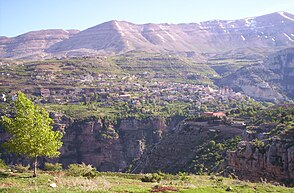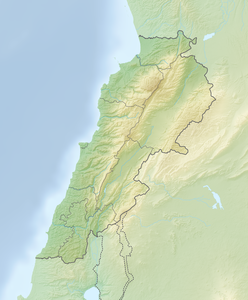Wadi Qadisha
| Wadi Qadisha | ||
|---|---|---|
| location | Bsharri in North Lebanon ( Lebanon ) | |
| Waters | Qadisha | |
| Mountains | Lebanon Mountains | |
| Geographical location | 34 ° 15 ′ N , 36 ° 1 ′ E | |
|
|
||
| length | 35 km | |
The Wadi Qadisha ( Arabic وادي قاديشا, DMG Wādī Qādīšā 'Sacred Valley') is a valley in the Lebanon Mountains and has been a UNESCO World Heritage Site since 1998. It is considered to be one of the most beautiful landscapes in Lebanon .
geography
Wadi Qadisha is located at the foot of Al-Makmal Mountain in northern Lebanon. It was formed by the Qadisha River, which rises in a cave just below the group of trees called "The Lord's Cedars". The total length of the valley is 35 km.
history
Wadi Qadisha was settled very early on. In addition to its beautiful nature, the valley is known for its numerous monasteries. Because the wadi is relatively isolated, it was used for centuries as a refuge for devout Christians who often suffered persecution. 1998, it was in the World Heritage Site of UNESCO was added because of its long Christian tradition. The most important place in the valley is Bisharri .
Monasteries of Wadi Qadisha
Qannubin Monastery
The Qannubin Monastery is considered the most important in Wadi Qadisha. It is located in the northeast of the valley and is the oldest Maronite monastery. The word qanubin comes from the Greek word kenobion, which means monastery. According to legend, the complex was founded by a student of the Byzantine emperor Theodosius I (347–395). From the 15th to the 19th century, the monastery was the seat of the Maronite Patriarch of the Qadisha Valley. The monk cells, accommodation for travelers and the church were carved into the rock. The latter is decorated with frescoes from the 18th century.
Quzhaya monastery
The Anthony Quzhaya Monastery is opposite the Qanubin Monastery. It is one of the largest monasteries in the valley and was probably founded in the 4th century. According to legend, this happened through St. Hilary, who built the monastery in honor of the Egyptian saint St. Anthony the Great. The oldest evidence, however, comes from the 12th century. The most important rooms are a meeting room and a chapel. An ethnographic museum is now housed in the premises. Among other things, a printing press from 1871 is on display. There is a mill and hermit caves near the monastery. These were used by religious hermits who had withdrawn into solitude to serve God.
Sayyidat Hawqa Monastery
Sayyidat Hawqa (To Our Lady of Hawqa) Monastery was founded in the 13th century. It is located at 1150 m above sea level on a rocky plateau between the Quzhaya and Qannubin monasteries. The monastery was partially built into a 47 m deep, already existing cave above the plateau. This part can only be reached via a ladder. Archaeological traces from the Stone Age to the Middle Ages have been found in the cave. In the chapel itself there is a Christian inscription in Arabic characters from 1193.
Mar Sarkis Monastery
The Mar Sarkis monastery is located at an altitude of 1500 m above the village of Ehden. It is also called "Qadisha's watchful eye". The first monastery church was built around 750 on the ruins of a Canaanite temple. In 1198 an additional church was built. Other structures were built between 1404 and 1690. The monastery was consecrated to Saints Sergius and Bacchus.
Mar Alisha 'Monastery
The monastery of Mar-Alisha 'was first mentioned in the 14th century. The building consists of four monk cells, a refectory and a church carved into the rock. Today the monastery shares a Maronite order with the barefoot order of the Carmelites .
The cedars of the Lord
Above the Wadi Qadisha is the grove of "the Lord's cedars" ( Arabic أرز الربّ). Some of these Lebanon cedar trees are believed to be the oldest in the region. They survived the deforestation from the Phoenician and Roman times. Cedar wood was a very popular building material for the Pharaohs, Assyrians and Israelites. However, due to overexploitation , the cedar forests dwindled more and more. Only a few cedar groves were disregarded by the loggers and were not cut down. The group of trees "Cedars of the Lord" at Bisharri consists of 375 trees. The age is controversial. Two of them are said to be 3000 years old, ten other trees over 1000 years old. On a clear day you can see the Mediterranean Sea as far as Cyprus from the cedars. In winter the area is a popular ski area, in summer a popular destination for Lebanese and tourists.
Web links
- http://www.qadisha.org
- Entry on the UNESCO World Heritage Center website ( English and French ).
- Wadi Qadisha and the cedars
literature
- Wolfgang Gockel : Syria. Lebanon (= Nelles Guide. ). Nelles, Munich 2010, ISBN 978-3-88618-824-6 .
Individual evidence
- ↑ UNESCO World Heritage Center: Ouadi Qadisha (the Holy Valley) and the Forest of the Cedars of God (Horsh Arz el-Rab). Retrieved August 29, 2017 .


